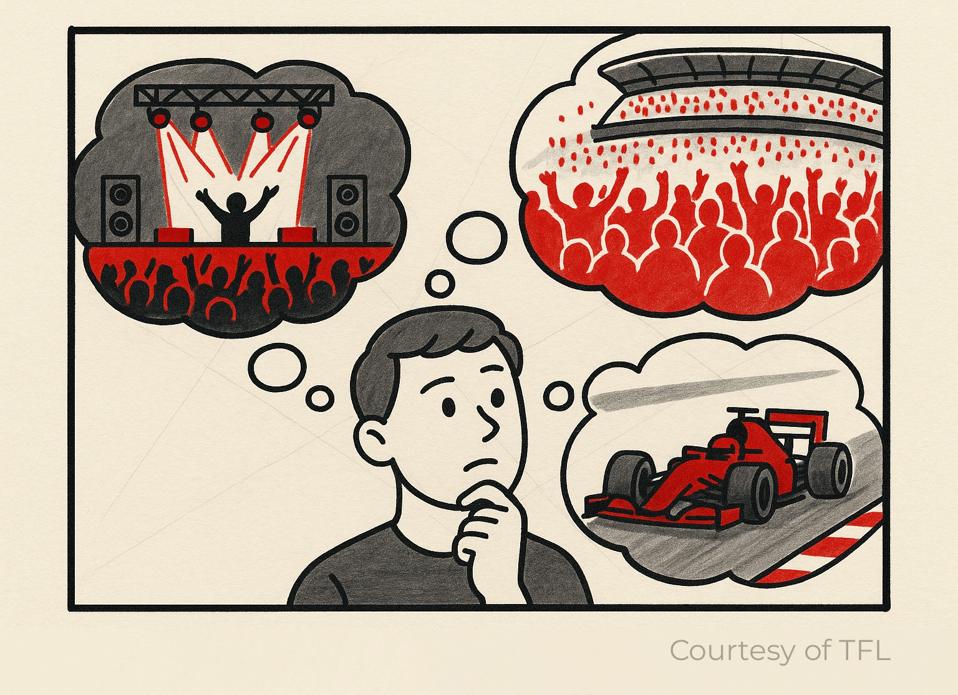Skift’s Chief Research Officer Seth Borko says live event tourism is a generational megatrend—and it’s forcing brands to rethink everything from loyalty redemptions to AI-powered service and discovery. The two of us visited at Skift’s signature NYC global event recently and I followed up to confirm key learnings.
The Moment You Book The Ticket Before The Trip
For decades, trip planning followed a neat, more linear order: pick a destination, buy the flight, choose a hotel, then figure out what to do. That funnel is flipping. More travelers—especially Gen Z and Millennials—start with the experience: a music festival, rivalry game, F1 weekend, once-in-a-lifetime celestial event, or headline residency. The destination becomes a byproduct of the moment.
Skift’s research team calls live event tourism a megatrend. Their market sizing pegs the global live events universe—sports, concerts, festivals, venues—at roughly $2.9 to $3.0 trillion in total tourism impact. In surveys across ten countries, about 20% of travelers said they’ve taken a trip primarily for a live event. Among younger cohorts (18–44), intent spikes significantly higher.
Why it matters: live events compress demand. Cities see peak occupancy, premium ADRs, extended stays, and spillover spend in dining and retail. Airlines test seasonal lift. Local brands ride the halo. And for loyalty programs, these moments are catnip—high emotion, high shareability, and (done right) high stickiness.
AI Isn’t A Gadget—It’s The New Travel Infrastructure
Borko’s other message: AI is moving from curiosity to expectation. In Skift’s U.S. traveler survey, those “extensively” using ChatGPT-style tools for trip planning jumped from 13% in 2024 to 30% in 2025. When asked if AI would influence provider choice, 33% said “much more likely” and 29% “somewhat more likely.” That’s a majority voting for smarter experiences.
Inside the industry, adoption is uneven. About 22% of travel executives report scaled generative AI across multiple functions—but just ~2% say the same for agentic AI (systems that take multi-step actions on your behalf). Expect the first big wins in the operational trenches: automated room assignments, proactive rebooking during IRROPs, FAQ deflection, and “smart delays” communication. These use cases reduce burnout, lift margins, and let frontline staff focus on guest care instead of middleware work. Moments that matter become more achievable when administrative tasks are reduced.
On the demand side, AI is already the place travelers discover and decide. Brands that surface the right offer, in the right context, with the fewest taps, will win the next booking—and the one after.
Live Tourism + AI: A New Planning Flywheel
Put the trends together and a practical playbook emerges:
- Start with the moment. Package event-led trips that bundle tickets, timed entries, pre- and post-event activities, and late checkout. Think “earn on the journey, redeem in the moment.”
- Build an AI concierge for discovery. If the planning funnel begins with “What’s on this weekend that fits my vibe and budget?”, your inventory, partner perks, and transportation options need to be query-able and bookable in one flow.
- Operationalize the crush. Major events create predictable spikes. Use AI to forecast surge windows, pre-assign rooms, right-size staffing, and pre-empt friction (transport tips, venue cut-off times, bag policies).
The Loyalty Rethink: Emotion Over IOUs
We also talked points. Yes, loyalty currencies can be incredibly valuable, and yes, co-brand partnerships have fueled growth. But Borko cautions against mistaking the balance sheet for the business. The points matter because the experience they unlock—United Polaris to Tokyo, a Bonvoy suite on derby weekend, a once-in-a-lifetime festival—feels premium.
Credit card issuers subsidize acquisition because travel is aspirational. That symbiosis works—until it doesn’t. If redemptions crowd out the truly loyal, or if card-driven earn decouples from brand-driven love, the proxy breaks. Loyalty is an emotion first; points should reflect that emotion, not replace it.
The fix isn’t complicated, but it is hard: protect capacity for your best customers, tie elite benefits to behaviors that show real brand commitment, and expand the redemption canvas beyond flights and rooms into culture—sports, music, culinary access—where more members can feel the win.
What Travelers Will Feel Next
- Experience-first planning: More trips will start with “What’s worth traveling for?” than “Where should I go?”
- Smarter redemptions: Expect clearer paths to value and expanded experiential inventory, not just seat upgrades that few can get.
- Friction-light service: Behind the scenes, agentic AI will quietly rebook, reassign, and resolve—before you ever queue at a desk.
- Neighborhood ecosystems: Partnerships (dining, fitness, local transport) will make loyalty feel less like a ledger and more like a lifestyle.
A 12-Month Playbook For Brands
- Codify your live-event calendar. Map tentpoles—stadiums, residencies, marathons, festivals—and stand up pre-built packages with dynamic holds on rooms and transport.
- Ship an AI “event mode.” One itinerary, one wallet, one customer thread for everything from gates to gates-open.
- Reserve joy for loyalists. Guarantee a slice of premium inventory (seats, lounges, hospitality) for members who demonstrate real behavior, not just card opens.
- Measure the moments. Track NPS and repeat intent for live-trip stays vs. baseline; invest where “I’d do that again” is highest.
- Train for the surge. Use AI to predict arrival waves and staff accordingly; pre-empt common issues with proactive, personalized comms.
The Bottom Line
Live event tourism is the emotional engine of modern travel, and AI is the transmission that makes it smooth. Together, they’re rewiring how trips are imagined, purchased, and remembered. Brands that design around the moment—and empower teams with intelligent tools—will capture the traveler’s heart and the second booking.

